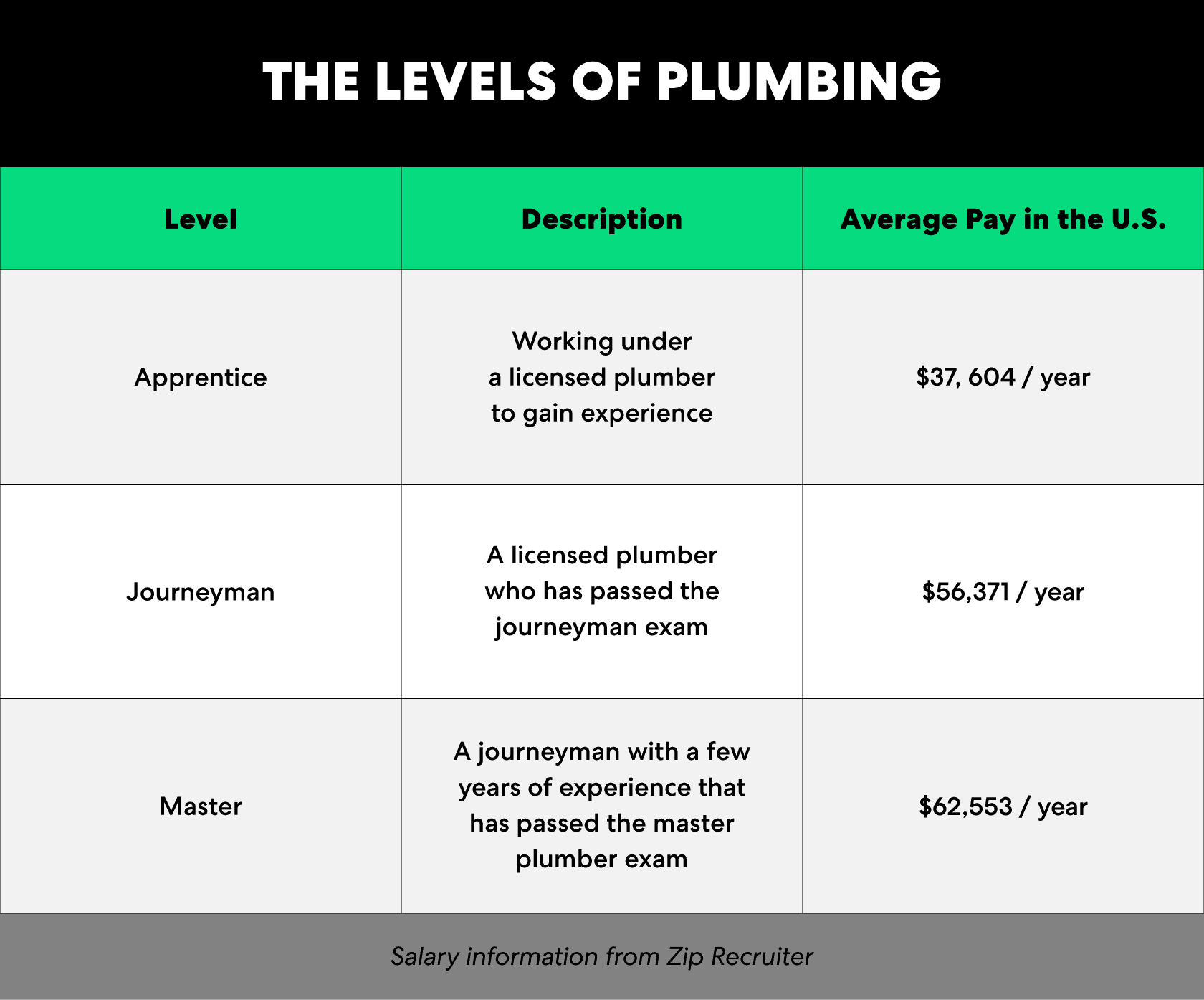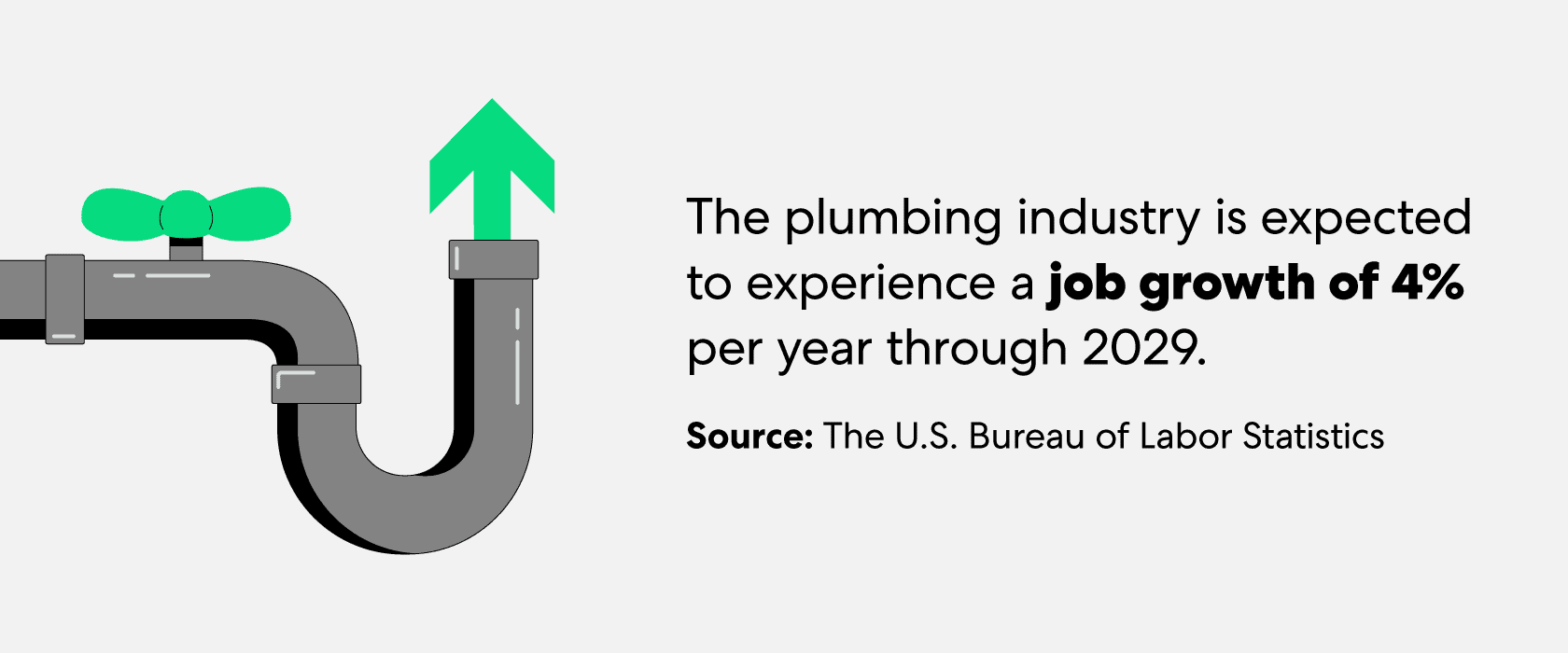The plumbing industry is awash with opportunities. From self-employed contractors running their own businesses to those working for an established plumbing company, people who want to become plumbers have many ways to do so.
And for anyone who considers becoming a plumber a pipe dream, now might actually be a good time to try your luck. The American plumbing industry is expected to grow 4% per year through 2029.1
That’s why we’ve created this guide to becoming a plumber in the United States. Here are the steps you need to get started:
1. Obtain a high school diploma or GED
Though most plumbing work doesn’t require a college degree, you’ll still need to obtain a high school diploma or a GED to get started in the field. Plumbers need to exhibit skill in math and science, which can be picked up during these courses. In order to pass a licensing exam and get ready to start plumbing, you’ll need a certificate from a high school or GED program.

2. Finish necessary training
There are two paths to complete plumber’s training: trade school or apprenticeships. Some people even choose to combine the two, first attending trade school and then entering an apprenticeship program. In dense areas where there are many prospective plumbers, trade school may give you a leg up on being accepted for an apprenticeship.
There are three levels of plumbers: apprentice, journeyman and master. Apprentices are those still enrolled in an apprenticeship program, and journeymen are those who have completed training and are ready to go out on their own. Those who don’t find training programs too draining may choose to become a master. Master plumbers must pass a master plumber exam and have years of experience as a journeyman plumber or have completed a master plumber training program.
3. Get a plumbing license
Though licensing requirements vary by state, you’ll need some sort of plumbing license to become a plumber in the U.S. Most licenses require a few years of experience — obtained through trade school or apprenticeships — and a passing grade on a licensing exam. To learn exactly what you’ll need, you’ll have to find your state’s plumbing license requirements.
4. Get insured
After finally getting your plumbing license, you don’t want to run into an accident that puts your finances down the drain. You can avoid a potentially expensive situation by taking care to insure your business before you start working. Plumbers liability insurance can cover third-party bodily injury, property damage and medical costs, keeping you protected in the event you have an accident on site.
5. Start working
With a license and insurance, you’ll finally be ready to start taking on plumbing jobs. Pick a business name and develop a business plan by analyzing your market and competitors. Then, you’ll finally be ready to start working.
You can choose to work for yourself as an independent contractor or get a job with a plumbing company, who will send you out on jobs. If you prefer being fully in charge of your own work, client list and salary, you may want to go solo; however, working for a company can provide you with guaranteed business and direction.
If you choose to work alone, you can start to get clients by posting about your business on social media or in local newspapers and magazines. From there, ask your customers to write reviews and recommend friends to your business. Jump to our infographic to learn more about how to market your plumbing business.

Plumbing career overview
With nearly a half-million plumbers working in the United States1 and projected job growth of 4% per year through 2029, the plumbing industry is a popular trade for those willing to put in the work to get certified. Let’s flush away some confusion about the industry.
How long does it take to become a plumber?
It will take roughly two to five years to become a plumber. Trade school programs last roughly two years and could help you pass the licensing exam to start working or get a paid apprenticeship. After or in place of trade school, an apprenticeship is a way that you can work as a paid plumber before branching out into your own business.
What qualifications do plumbers need?
Plumbers will need a high school diploma or GED, a passing grade on a licensing exam, a business license and a few years of experience. With these under your belt, you’re ready to get started with your own plumbing business as a journeyman plumber, the first level of plumbing out of trade school.
Master plumbers require a bit more training before they’re certified. Most states require plumbers to work as a journeyman plumber for several years and then pass a master plumbing exam before they can become certified masters.
How much do plumbers make?
In 2020, the median salary for plumbers was about $56,000 per year.1 The lowest 10% of plumbers made less than $34,000, and the highest 10% of plumbers made more than $98,000.1
In the United States, plumbers earned the most in: Illinois, $86,000/year; Alaska, $79,610; Minnesota, $74,700; New Jersey, $74,360; and Massachusetts, $73,970.2
Must-have tools for plumbers
Dealing with everything from toilets and showers to kitchen sinks and water heaters, plumbers can perform a diverse range of tasks. And usually, this means they’ll need a diverse set of tools to tackle anything that comes their way.
A few things that plumbers might rely on to pad their toolboxes include the following:
- Pipe wrench
- Adjustable wrench
- Measuring tape
- Gloves
- Bucket
- Hacksaw
- Drain snake
- Caulk gun
- Safety glasses and goggles
- Pencils and markers
- Plunger
- Pipe cutters
- Pliers
- Knee pads
- Flashlight
Apps to help plumbers work
Plumbers often have a busy schedule, sometimes with multiple calls in one day. There are several apps that can help you stay on time and on track during your workday.
For organizing: Housecall Pro
Cost: Free, with in-app purchases
Available on: iPhone, Android
Housecall Pro works to automate parts of the scheduling and payment process, making day-to-day operations easier for plumbers. You can create custom estimates, convert those estimates to job tasks and invoices, and even process payments on the app. For those with employees, you can also notify and dispatch workers to job sites via the app.
For accounting: Quickbooks for Plumbers
Cost: Tiered levels starting at $7.50/month
Available on: iPhone, Android
Keeping track of your ledgers can be one of the most tedious parts of running a small business. Quickbooks aims to reduce some of that tedium by balancing your books for you to make sure you’re always ready for tax season. Using Quickbooks, you can invoice and keep track of income and spending, track mileage hours and estimate taxes.
For logistics: Plumbing Formulator
Cost: Free, with in-app purchases
Available on: iPhone
If you can’t calculate the weights of different pipes off the top of your head, we don’t blame you. But you will most likely need a few formulas when doing plumbing work to make sure everything fits and works as it should. Plumbing Formulator includes over 100 different formulas that can help plumbers do their jobs, so it’s a helpful tool to have on hand.
For efficiency: Route4Me
Cost: Free, with in-app purchases
Available on: iPhone, Android
We don’t blame you if you don’t want to drive north, then south, then north again while on your job route. That’s where Route4Me comes in. You can input your job sites into the app, and it will calculate the most efficient route for you to take so you can get your jobs done without any unnecessary driving.
Once you’ve finally put in the work to become a plumber and start your own business, don’t let it go down the drain. Keep yourself protected by investing in a good plumbing insurance — like Thimble’s — to keep your business safe.
Sources:












